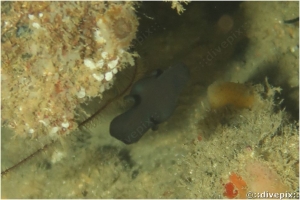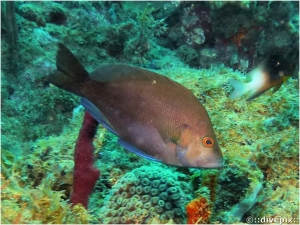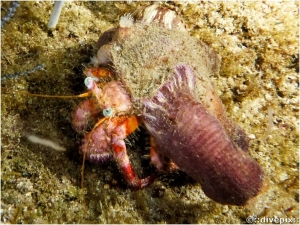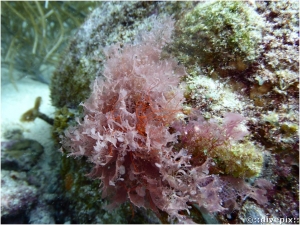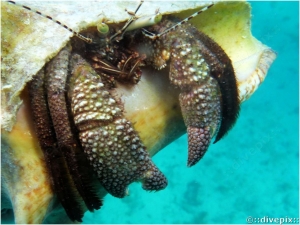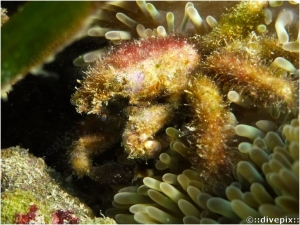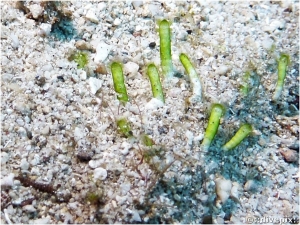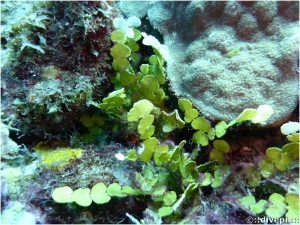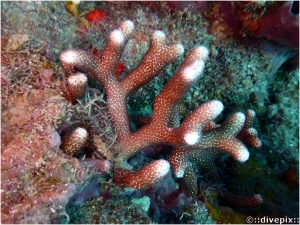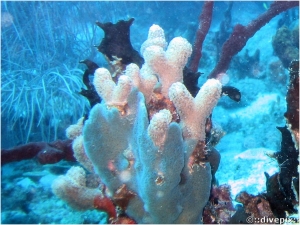




Eric H. Biass
Flat Worm, a.k.a. Flatworm and Platyhelminthes
| Aspect: | Relatively short brownish ribbon (but can also sport different colours or combinations of colours). Platyhelmintes, or even Plathelminthes derives from the Greek platy (flat) and helminth (worm) |
| Population: | Probably abundant, but rarely spotted. |
| Notable feature: | Undulates its entire body to swim. |
| Environment: | Anywhere relatively sheltered from strong currents. |
| Behaviour: | Carnivorous, feeds on small crustaceans, essentially at night. |
Tan Hamlet
| Aspect: |
Uniform dark tan body, lighter towards the head and belly, no particular markings. |
| Population: | Uncommon, and in fact only recently formally described and named as "Hypoplectrus randallorum", as confirmed by WORMS (see here). Easily mistaken for a small snapper although both the almond-shaped eyes and blue ventral and anal fins eliminate the option. Until recently (2011) the only reference book that actually identified it as "Tan Hamlet" was Humann's Reef Fish Identification which gave the scientific name "Hypoplectrus sp.". |
| Notable feature: | Blue ventral and anal fins, with first spine of ventral fins lighter blue. Dark brown tail fin. |
| Environment: | Near bottom, close to rocks or coral boulders able to provide shelter. |
| Behaviour: | Not too shy if approached gently. |
Anemone Hermit
| Aspect: | The hermit (here probably a Stareye Hermit (q.v.), carries two or more stinging tentacle anemones on its adopted shell, generally Calliactis tricolor (q.v.), for its protection, notably against octopusses. In return, the anemone can count on a steady food supply resulting from the hermit's meal debris. The vernacular name of this particular species of anemone actually is "hitchhiking anemone". There apparently are several species of Hermits that adopt the company of protective anemones. |
| Population: | Occasional. |
| Notable feature: | The Hermit transfers the anemones when it changes shell for a larger one. |
| Environment: | Sandy surfaces, but near rocks for quick shelter. |
| Behaviour: | Relatively shy. |
Martensia Pavonia Alga
| Aspect: |
Pink fanning leaves. These grow as plain sheets from a whiter stem but imediately start taking their characteristic rectangular pattern lace aspect. Remark: oddly, given the widespread nature of this alga (one amongst several Martensia species) and the fact that it was identified by Swedish botanist Jakob Agarth in 1856, the species does not seem to have been scientifically described. Hence lack of real English or French designation. |
| Population: | Widespread. |
| Notable feature: | Top centre edge of each leaf boasts a small plain round plate, reminiscent of a jewel atop a crown . |
| Environment: | Grows on rocks in shallow water. |
| Behaviour: | - |
Giant Hermit
| Aspect: | Fat white-studded green main legs with large claws, smaller legs are brownish, but covered in smaller studs. |
| Population: | Occasional. |
| Notable feature: | Bright green eyes topped with eyelash-looking cirri. Long brown banded antennae. Considered the largest Caribbean hermit crab, hence squats Queen Conch shells. |
| Environment: | Sandy bottoms. |
| Behaviour: | Retracts when approached too closely, but will then slowly pull out again. |
Anemone Crab or Banded Clinging Crab
| Aspect: | Very hairy small crab (body hardly 2cm long) appears brown with reddish top. Sans fur, it would appear cream coloured with brown bands |
| Population: | Probably common but difficult to spot. |
| Notable feature: | Black and white mosaic eyes. |
| Environment: | Usually found in Gian Anemones in shallow waters. |
| Behaviour: | Does not appear to be too shy. |
Fuzzy Tip Alga
| Aspect: | Tiny (barely 2cm long) green-tipped shoots, with white stem. |
| Population: | Probably more than one can actually see. |
| Notable feature: | A fuzzy halo of ultra-thin "airs" can be perceived around the green cap when looked at very closely. This close-up observation also reveals a ringed structure, hence the scientific designation (annularis). |
| Environment: | May grow straight out of the sand in no particular environment. |
| Behaviour: | - |
Large-Leaf Hanging Vine
| Aspect: | Chains of flat heart-shaped geen leaf segments linked together from base to apex by a thin strand running through their midribs. |
| Population: | More common along the coast facing Ilets Pigeon. |
| Notable feature: | Leaves look as thick as those of a succulant plant. |
| Environment: | Grows against steep slopes or walls. |
| Behaviour: | - |
Thin Finger Coral
| Aspect: |
Brown to Purple colonies of thin and randomly branching fingers. Variants: - Porites furcata or Branched Finger Coral (q.v.); lighter colour (almost white), tips tend to fork out (hence its name). - Porites porites or Clubtip Finger Coral (q.v.): thicker and shorter branches with barely branching tips. |
| Population: | Common. |
| Notable feature: | - |
Branched Finger Coral
| Aspect: |
Colonies of white thick and somewhat verical stems that split into pronounced branches. Variants: - One variant is known as Porites poites (Club Finger Coral, q.v) with stem tips that only produce stumpy branches. - A second variant is know as Porites divarticata (Thin Finger Coral), is much slender and features much more prominent branches with a coloration that ranges from red-brown to ourtright purple. |
| Population: | Abundant |
| Notable feature: | - |



